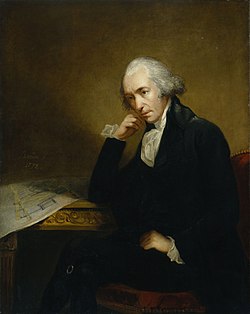James Watt
| James Watt | |
|---|---|
 Portrait of James Watt (1736-1819) by Carl Frederik von Breda | |
| Ìbí | 19 Oṣù Kínní 1736 Greenock, Renfrewshire, Scotland |
| Aláìsí | 25 August 1819 (ọmọ ọdún 83)[1] Handsworth, Birmingham, England |
| Ibùgbé | Glasgow then Handsworth, Great Britain |
| Ará ìlẹ̀ | Kingdom of Great Britain |
| Ọmọ orílẹ̀-èdè | Scottish |
| Pápá | Inventor and Mechanical Engineer |
| Ilé-ẹ̀kọ́ | University of Glasgow Boulton and Watt |
| Ó gbajúmọ̀ fún | Improving the steam engine |
| Religious stance | Church of Scotland[2] |
| Signature | |
James Watt, FRS, FRSE (19 January 1736 – 25 August 1819)[1] je omo Skotlandi adasile ati onimo iseero elero.

|
Àyọkà yìí tàbí apá rẹ̀ únfẹ́ àtúnṣe sí. Ẹ le fẹ̀ jù báyìí lọ tàbí kí ẹ ṣàtúnṣe rẹ̀ lọ́nà tí yíò mu kúnrẹ́rẹ́. Ẹ ran Wikipedia lọ́wọ́ láti fẹ̀ẹ́ jù báyìí lọ. |
Itokasi[àtúnṣe | àtúnṣe àmìọ̀rọ̀]
- ↑ 1.0 1.1 Although a number of otherwise reputable sources give his date of death as 19 August 1819, all contemporary accounts report him dying on 25 August and being buried on 2 September. The date 19 August originates from the biography The Life of James Watt (1858, p. 521) by James Patrick Muirhead. It draws its (supposed) legitimation from the fact that Muirhead was a nephew of Watt and therefore should have been a particularly well-informed informant. In the Muirhead papers, however, the 25 August date is mentioned elsewhere. The latter date is also given in contemporary newspaper reports (for example, page 3 of The Times of 28 August) as well as by an abstract of and codicil to Watt's last will. (In the pertinent burial register of St. Mary’s Church (Birmingham-Handsworth) Watt's date of death is not mentioned.)
- ↑ Carnegie, Andrew. James Watt. The Minerva Group, Inc.. pp. 215. ISBN 0898755786, 9780898755787. http://www.jameswatt.info/andrew-carnegie/9-watt-in-old-age.html.
